1 Fourier series, Gibbs phenomenon, generalised series.
Contents
1 Fourier series, Gibbs phenomenon, generalised series.#
# import all python add-ons etc that will be needed later on
%matplotlib inline
import numpy as np
import matplotlib.pyplot as plt
from scipy.integrate import quad
from sympy import *
init_printing() # allows printing of SymPy results in typeset maths format
plt.rcParams.update({'font.size': 14}) # set font size for plots
1.1 Motivation and concept#
The Taylor and Maclaurin series reconstruct functions as an infinite series in the powers \(x^n\), and the coefficients needed to do this are the derivatives of the function. These series have rather tight restrictions placed upon them; the function must be differentiable \(n\) times over and the remainder must approach zero. These are described in Chapter 5. In a Fourier series, the expansion is performed instead, as trigonometric series in sines and cosines, with two sets of coefficients, \(a_n\) and \(b_n\), to describe the \(n^\text{th}\) term, and which are evaluated by integration. The series formally extends to infinity, but in practice, at most only a few tens of terms are needed to replicate most functions to an acceptable level of approximation. The advantage of using a Fourier rather than a Taylor/Maclaurin series is that a wide class of functions can be described by the series, including discontinuous ones. However, by their very nature, Fourier series can only represent periodic functions, and this must not be forgotten. Periodic means that the function repeats itself; the repeat interval is normally taken to be \(-\pi\) to \(+\pi\) but can be extended to the range \(-L\) to \(L\) and \(L\) can even be made infinite.
To illustrate that it is possible to make an arbitrary shaped function by adding a number of sine and cosine waves, four such waves are shown in Fig.1. It is possible to imagine, without any difficulty, that waveforms that are more complex can be formed by using more sine or cosine terms. The lowest and most complicated waveform is simply the sum of the individual waves, and repeats itself with a period of 2\(\pi\). This waveform could be the signal that is measured on an oscilloscope or spectrometer and recorded on a computer. It might alternatively, be part of an image that is formed from adjacent columns of different waveforms. Periodic components present in a signal represent information in the waveform or image can be retrieved by performing a Fourier transform. This unravelling process is discussed later on but now the Fourier series is considered.
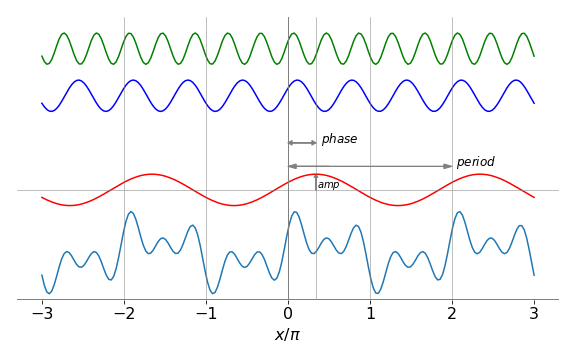
Figure 1. A complex and periodic waveform or function is constructed out of the sum of sine and/or cosine waves. The complicated waveform, repeats itself with a period of 2\(\pi\). In the Fourier series, the reconstruction of this waveform will require many more sine and cosine terms to reconstruct its form than are used to generate it, because the Fourier series only represents a function exactly when an infinite number of terms are included in the summation. The phase and period shown with arrows relate only to the cosine (red waveform) with a period of \(2\pi\). The wavelength \(\lambda\) is the distance when \(x/\pi=2\). The phase is the distance the peak of the waveform is at when measured from \(x=0\), and the amplitude the size of the wave at its maximum, measured from zero displacement shown as the thin horizontal line.
1.2 The Fourier Series#
A Fourier series aims to reconstruct a function, such as a waveform, using the weighted sums of sine and cosine functions or their exponential representations. The great importance and usefulness of the Fourier series is that they represents the best fit, in a least-squares way, to a function \(f(x)\) because
is minimized when \(g(x)\) is the Fourier series expansion of \(f(x)\).
Because the Fourier series can extend to infinity, many more sine and cosine terms can be used to exactly reproduce a waveform, such as that shown in Fig. 1, than were used to produce it in the first place. The Fourier series cannot somehow magically pick out just those sine and cosine waves used to make the original function, therefore very many terms each with a unique frequency are needed to faithfully reconstruct a waveform.
If the waveform shown in Fig. 1 were truncated so that it was zero outside \(x = \pm \pi\), for example, then its Fourier series would have to match this new waveform which suddenly becomes zero and do so a series must contain a sufficiently large number terms not only to cancel out to zero outside the range \(x = \pm \pi\), but also to reproduce the function inside the range.
Suppose that, over the range \(\pm\pi\), a Fourier series \(g(x)\) approximates a ‘victim’ or target function \(f(x)\), which might be \(x^3\) or \(\displaystyle (e^{-x} - 1)^2\) or any ‘normal’ function, then the Fourier series \(g(x)\) that approximates the true function \(f(x)\) can be written down in general and in quite a straightforward manner and is
where \(g(x)\) approximates \(f(x)\). The summations start at index \(n\) = 1, and \(n\) is a positive integer. The \(a_n\) and \(b_n\) coefficients are the integrals
which are normalized by 1/\(\pi\).
When the number of terms in the series is large, then \(g(x) \rightarrow f (x)\), and when infinite, \(g(x) = f (x)\). At each value of \(x\), the Fourier series consists of a constant term, \(a_0\)/2 plus the sum of an infinite number of oscillating terms in integer multiples of \(x\). Notice, that the target function \(f(x)\) appears as part of the expansion coefficients only, and must, therefore, be capable of being integrated. The target function \(f(x)\) determines the weighting to be placed on each term in the expansion, and this is how information about the shape of \(f(x)\) is included in the expansion.
If \(f(x)\) is periodic in time, then the variable \(x\) would normally be changed to \(\omega t\) where \(\omega = 2\pi\nu\) is the angular frequency in units of radian s\(^{-1}\), and \(\nu\) is the frequency in s\(^{-1}\). If the dimension is spatial, then \(x\) is often replaced with \(2\pi x/L\) of which \(2\pi/L\) can be interpreted as a spatial frequency, with units of radians m\({-1}\) by analogy with ‘normal’ frequencies. Often this spatial frequency is called the wavevector and given the symbol \(k\).
Before a worked example, it is worthwhile examining limits other than \(\pm\pi\), describe the exponential form of the series and also simplifying some series using symmetry. The \(a_n\) and \(b_n\) constants are also derived.
1.3 Series limits from \(-L\) to \(L\)#
Over the range \(−L\) to \(L\), the equations to use for \(f(x)\) are similar to equations (1)–(3) but \(x\) is changed to \(\pi x/L\). The series is
and the coefficients are changed similarly,
Notice that the arguments, limits, and normalization are each changed compared to those when the range is \(\pm \pi\). The integral now has limits \(\pm L\) instead of \(\pm \pi\), and normalization 1/\(L\) rather than 1/\(\pi\).
1.4 Exponential representation#
Because the sine and cosine functions can be represented as sums and differences of complex exponential terms, for example, \(\displaystyle \cos(x) = (e^{ix} + e^{-ix})/2\), the most general way of describing the Fourier series is to use the complex exponential form;
and the coefficients become
Note the change in sign and limits in the second exponential, and that \(i=\sqrt{-1}\). The set of coefficients \(c_n\), are sometimes called the amplitude spectrum of the transform. Note also that for practical purposes the expansion \(g(x)\), and the true function \(f(x)\) are considered equivalent.
1.5 Deriving the integral describing the \(a\) and \(b\) coefficients#
The integrals describing the coefficients \(a_n\) are obtained by multiplying each term in the Fourier series by \(\cos(mx)\), where \(m\) is an integer, then integrating term by term using the orthogonality of sine and cosine integrals as necessary. The coefficients \(b_n\) can be obtained similarly by multiplying the series by \(\sin(mx)\) and integrating.
First, the form of the cosine integrals is examined. The integrals containing a product of sine and cosine are all zero for any \(n\) and \(m\) because the integral has ‘odd’ symmetry because of the sine, and the limits are symmetrical;
To convince you that the symmetry makes the integral zero, which is the area under the curve, a curve is plotted below, see figure 2. The curve, while complicated, is inverted about \(x\) = 0 so that the area \(\gt\) 0 is equal and opposite to that \(\lt\) 0. More details on odd and even functions is given in the next section.
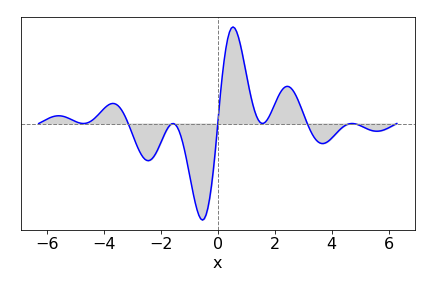
Figure 2. An odd function such as shown above has zero integral when evaluated over a symmetrical region about zero.
The product of two cosines makes the integral
where \(m\) and \(n\) are integers and the (Kronecker) delta function \(\delta_{n,m}\) is zero only if \(n \ne m\), and is \(1\) if \(n = m\).
To calculate the \(a_n\) coefficients, \(f(x)\) is represented as the Fourier series \(g(x)\)
and this is now multiplied by \(\cos(mx)\) and integrated. The cosine integrals with \(m\gt\) 0 are,
These integrals can be easily evaluated: The first is zero by symmetry, and by direct integration,
The integral containing \(b_n\) is given by eqn. 10 and is zero also when \(n \ne m\), therefore eqn. 12 becomes
because the delta function picks out just one term from the summation. Rearranging gives
The index has been changed to \(n\) from \(m\) because both \(n\) and \(m\) are integers and only one index is needed; equation (11) was written initially with \(n\), so this is again chosen. When \(m = n =\) 0, equation (12) becomes
making
Similar arguments lead to the calculation of \(b_n\).
1.6 Odd and even functions#
When functions are either even or odd, the Fourier series is simplified to cosine or sine series respectively. An even function has the property \(f (-x) = f (x)\) and the sine integration (eqn. 6) producing the Fourier coefficient \(b_n\) is odd and therefore \(b_n\) = 0, but only because the integration limits are symmetrical. The cosine integral (eqn. 5) is not zero, and can be written as
When \(f(x)\) is odd \(f(-x) = -f(x)\), the opposite situation arises; \(a_n\) = 0 and only the sine terms remain;
In cases when \(f(x)\) is neither odd nor even, for example \(f(x) = \pi/2 - x\), both coefficients have to be evaluated.
As an example, consider calculating the series of \(f(x) = x^2\) over the range \(\pm \pi\). Because this is an even function, the sine integral should be zero and \(b_n\) = 0. The \(a\) coefficients are
and when \(n\) = 0,
When \(n\gt\) 0, \(a_n\) can be evaluated using integration by parts.
#using SymPy to do the indefinite integration
x, n = symbols('x, n', positive = True)
func = x**2*cos(n*x)/pi
a_n = integrate(func,x, conds='none') # coefficients a_n
a_n

Adding the limits \(\pm \pi\) produces zero for the sine terms and the remaining cosine produces \(\displaystyle a_n=(-1)^n\frac{4}{n^3}\). All the \(b_n\)=0 thus using eqn. 4. the Fourier series for \(x^2\) is
which, as shown in the next figure, is a good representation of \(x^2\). The following Python code is included as an example of a Fourier series calculation
# Fourier series calclation
fig1= plt.figure(figsize=(12.5, 5.0))
plt.rcParams.update({'font.size': 16}) # set font size for plots
ax0 = fig1.add_subplot(1,3,1)
ax1 = fig1.add_subplot(1,3,2)
ax2 = fig1.add_subplot(1,3,3)
gx = lambda x, k : (np.pi**2)/3.0 + 4.0*sum( (-1)**n *np.cos(n*x)/n**2 for n in range(1,k)) # g series summation
x = np.linspace(-2*np.pi,2*np.pi,200) # define x values, -pi to pi with 200 data points
for i, ax in enumerate([ax0, ax1]):
j = 20
if i == 0 :
j = 3 # number of terms in summation
ax.plot(x/np.pi, gx(x,j),linestyle='dashed',color='black',label='max n = '+str(j)) # plot as x/pi , 4 terms
ax.plot(x/np.pi,x**2,color='red')
ax.set_xlabel(r'$x/\pi$')
ax.set_ylim([-1,15])
ax.axhline(0)
ax.legend()
kk = 10
nvals = [i for i in range(kk) ] # make list of values 0, 1, 2,...
fn = lambda n : (np.pi**2)/3.0 if n ==0 else (-1)**n/n**2 if n > 0 else 0
an = [ fn(i) for i in range(kk) ] # make list of fn(0), fn(1) etc
ax2.axhline(0,linewidth=1, color='grey')
ax2.bar(nvals,an,label=r'$a_n$ coefficients')
ax2.set_ylim([-2,4])
ax2.set_xlabel('n')
ax2.legend()
plt.tight_layout()
plt.show()
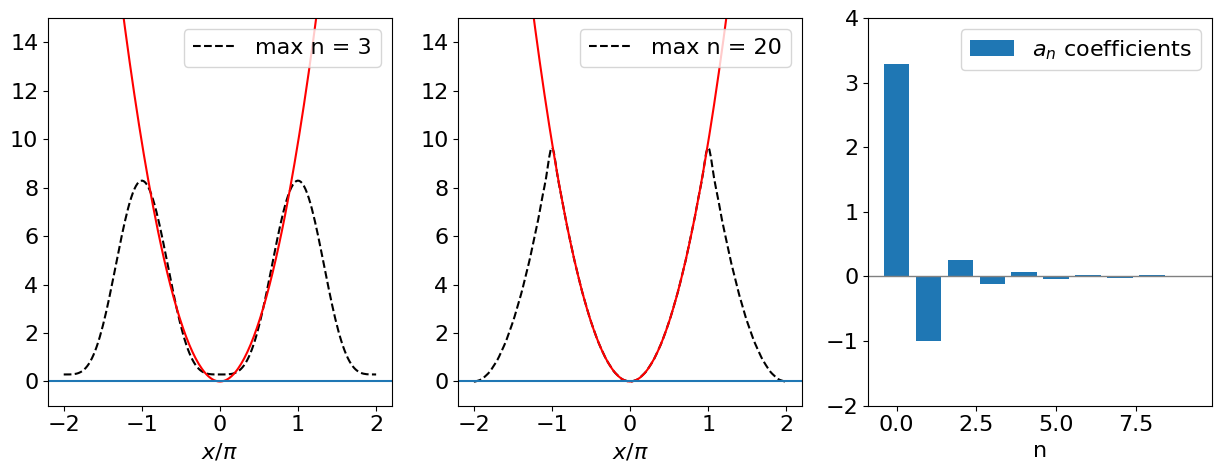
Figure 3. Left: Plot of \(x^2\) and its Fourier series to \(n\) = 3 showing a poor fit to the true function. More terms produce a better fit but only over the range \(\pm \pi\) as shown in the centre panel where 20 terms are included in the summation. This plot also shows how the fit is only over the range \(\pm \pi\) and then it repeats itself. On the right are shown the coefficients \(a_n\) and shows how rapidly their value decreases as \(n\) increases.
1.7 Discontinuous functions#
The square wave shown in Fig. 4, has a stepwise discontinuity. When \(x \ge 0,\; f(x) = 1\), and when \(x \lt 0, f (x) = -1\) and the wave repeats itself with a period of \(2\pi\). This discontinuous function is sometimes called the odd signum function, sgn(\(x\)). It can be shown that, if the discontinuity occurs in the mid range \(-\pi \to \pi\), each integral, \(a_n\) and \(b_n\), can be split into two, one being taken from \(-\pi \to 0\) and the second from \(0 \to \pi\). The Fourier series expansion now has coefficients
and when \(n = 0\),
and because the function has odd symmetry \(f(-x) = -f(x)\), the cosine integrals and all other \(a\) coefficients are zero,
The \(b\) coefficients are
However, when \(n\) is even, the coefficient \(b_n\) is zero, because for integer multiples of \(\pi\) the cosine is one, and when \(n\) is odd the cosine is \(-1\), consequently \(b_n = 4/n\pi\). The Fourier series equation (1) reduces to
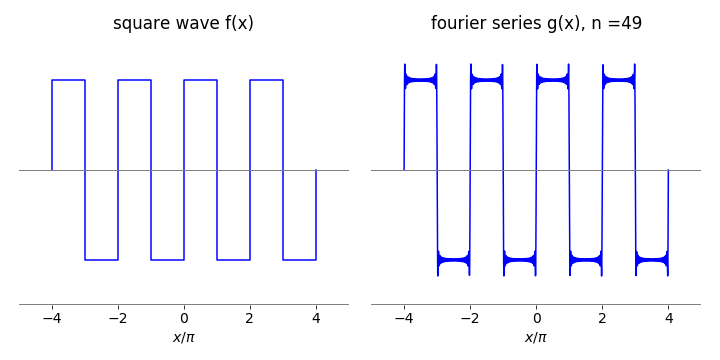
Figure 4. A few cycles of a square wave, which is a discontinuous function. Left shows the function \(f(x)\) and right its Fourier reconstruction \(g(x)\) via a series of \(n = 49\) terms. The over- and undershoot in the Fourier series as shown on the right hand plot is a phenomenon called the Gibbs phenomenon and is discussed next.
1.8 The Gibbs phenomenon#
The Fourier series of a square wave is shown in fig 4 (right) with a relatively large number of terms. Adding more will improve the fit to the function, but it will never be exact because an infinite number of terms will be needed to follow the right-angled bends at the top and bottom of the wave. This angle effectively corresponds to an infinite sine frequency.
The size of the overshoot remains the same independent of the number of terms; this is called the Gibbs’ phenomenon, after J. Willard Gibbs, of thermodynamics fame, who explained its cause as being due to the non-uniform convergence of the Fourier series in the vicinity of a discontinuity.
It is difficult to prove, but may be seen quite easily graphically; plot the Fourier series approximation to the square wave, say, from \(-0.2 \to +0.2\) and with different numbers of terms in the series, and then observe the height of the overshoot. As more terms are added, this becomes closer to zero, but its amplitude above \(1\) and below \(-1\) remains the same, as shown in the next figure for \(10\) and \(100\) terms in the series.
The Gibbs phenomenon was first observed by Michelson who is more famous for the interferometric Michelson - Morley experiment that determined that the speed of light was independent of the position of the earth and thus disproved the hypothesis of the aether. By 1898 Michelson had constructed a machine, called the Harmonic Integrator, that could calculate up to eighty terms in a Fourier series and present the results graphically. He noticed the overshoot and wrote to Gibbs for an explanation thinking his machine was in error. You can see a photograph of this machine in ‘A Student’s Guide to Fourier Transforms’ (James 1995). This book also contains a clear introduction to Fourier transforms.

Figure 5. The Gibbs phenomenon where the over- and undershoot remain at the same size as more and more terms are added to the Fourier series.
2 Integrating, differentiating and summing series#
If the series for a function \(f(x)\) has been calculated then that for \(\int f(x)dx\) can be easily calculated, providing that the integration can be performed. Similarly if \(df(x)/dx\) is available the series for this can also be obtained. As an example, the series for \(x^4\) can be obtained from the Fourier series for \(x^3\) by integrating term by term; in addition, integration can lead to a better representation of a function with the same number of terms in the summation. The algebraic result will be different from that of a direct series for \(x^4\), but should be just as good a representation.
The series for \(x^3\) is calculated first and as this is an odd function, all the even cosine terms are zero; therefore, all the \(a\) coefficients are zero and the series only contains sine or \(b\) terms of the form
This and similar integrals can be integrated ‘by parts’ or the sine converted to an exponential and then integrated; in either case the sine or exponential part is integrated first, so that the power of \(x\) is reduced in the second term of the ‘by parts’ integration. Using sympy the result is shown below.
x = symbols('x' )
n = symbols('n',integer=True)
f01 = x**3*sin(n*x)/pi
bn = integrate(f01,(x,-pi,pi),conds='none')
simplify(bn)

As the sine terms are all zero and the cosines alternate 1 for even \(n\) or -1 for odd \(n\) in the limits \(x=\pm n\pi\) and with \(n \gt\) 0, the integral is \(b_n=2(-1)^{n+1}(\pi^2/n - 6/n^3) \). The expansion of \(x^3\) is therefore,
The series expansion is plotted in Fig 6; notice how the difference in the value of the series for \(x^3\) is greatest at the limits \(\pm \pi\), and how the series repeats itself. The Fourier series is zero at both -\(\pi\) and \(\pi\) because it assumes that the function \(x^3\) is periodic; thus just before \(\pi\) its value is \(\pi^3\), and just after -\(\pi^3\), and this leads to an overshoot.
Integrating term by term produces a new series, which is,
and the initial \(8\) arises because the integration of \(x^3\) is \(x^4\)/4 and \(b_n\) was evaluated for \(x^3\). The curve for \(x^4\) and its Fourier series is shown in Fig.6. The fit is good up to the limit \(\pm \pi\), the limit of the initial Fourier series. The \(x^4\) series \(g(x^4)\) is smoother than the \(x^3\) and also a better fit to the curve, and this may be attributed to the integration, which measures the area under a curve and has the effect of smoothing the function.

Figure 6. The functions \(x^3\) and \(x^4\) are shown as dashed lines. The wiggly solid curve shows the result of having only 20 terms in the \(x^3\) summation. The underlying oscillation of the trigonometric terms is obvious, even though the series clearly approximates \(x^3\). The \(g(x^4)\) series, after integrating the \(x^3\) Fourier series, is a considerably better fit than is the fit to \(x^3\).
2.1 Summations#
The Fourier series can also be used to evaluate summations; for example the expansion of \(x^2\) in the range \(\pm \pi\), equation (15), gives
When \(x=\pi/2\), the series produces the result
where the series limit is taken to infinity. In fact, this series converges very slowly; the alternating sign in \(\pm 1/n^2\) terms ensures this, and about 360 terms are needed to obtain a value for π accurate to five decimal places: not really a good way to calculate \(\pi\). When \(x\) = \(\pi\) the series is
which converges more rapidly as all the terms have the same sign. Many other unusual summations can be achieved using different Fourier series; however, for us they are only curiosities.
3 Some formal points about the Fourier series#
The sine and cosines making up the Fourier series have two important properties: orthogonality and completeness.
In the language of vectors, the sine and cosine functions represent a complete orthogonal basis set on which the target function, \(f(x)\), is expanded as a sum of \(N\) terms. This basis set is of infinite length and is
where \(n = 1, 2, \cdots\), and there is a similar set for the cosines with \(n\) \(\ge\) 0. Any desired accuracy can be achieved, provided that \(N\) is large enough. If the basis set functions are also normalized, the set is orthonormal rather than just orthogonal.
Basis sets often seem rather abstract because we do not often need to use them explicitly. For example, although not normally described in this way, the exponential function
is, by contrast, an expansion in the basis set of \(x^n\) and the coefficients are
This basis set is not orthogonal because the condition for this to apply is that the product of any two elements is zero when taken over the whole range of the set, \(\pm \pi\) for sine and cosine. The dot product of any two orthogonal vectors is zero, see Chapter on Vectors section 2.
Similarly for the sine and cosine basis set even though it is continuous, the condition is
which is zero if \(m \ne n\). This is not true of the coefficient of the \(x^n\) basis set of the exponential expansion, thus we cannot form a Fourier series based on this.
The great importance and usefulness of the Fourier series is that it represents the best fit, in a least-squares way, to any function \(f(x)\) because \(\displaystyle \int_{-L}^{L}[f(x)-g(x)]^2dx\) is minimized when \(g(x)\) is the series expansion of \(f(x)\).
A given set of functions, \(S_n(x)\) is said to be complete if some other arbitrary function \(f(x)\) can be expanded in the set of the \(S\) functions. If they have the same boundary conditions, this makes the functions complete and orthogonal in a given range, and in the case of the sine and cosine Fourier series, this range is -\(\pi\) to \(\pi\). The general series describing \(f(x)\), is
\(q_n\) being constants that are related to the target function \(f(x)\). If the \(S\) functions are orthonormal, then, when \(n\) and \(m\) are integers,
In modern mathematics, the term ‘Fourier series’ does not refer just to the original sine and cosine series, or their complex exponential representation, but to a series formed by other functions that form a complete orthogonal basis set. Often the term generalized Fourier series is used to describe these, but this is not universal. The sine or cosine functions are not unique in forming series and many other functions could be used provided that they can form an orthogonal set. Other such functions include the Hermite polynomials, used to describe the harmonic oscillator wavefunctions, and the Legendre and Chebychev polynomials. In Section 4 it is shown how these can also be used to form series that describe arbitrary target functions \(f(x)\).
3.1 A general method for numerically calculating a Fourier series#
An algorithm is given below with which to calculate the Fourier series of a function and is fairly straightforward if equations (5) and (6) are used and care taken over the integration limits. The function is placed in the first line as and the range is from \(\pm 7\), in this example. The target function is
The equations (4 to 6) in section 1.2 are used. The series is calculated numerically and the result of the calculation is shown in Fig. 7 and is compared with the original function, and for most of the curve the fit is tolerably good but not excellent. The main discrepancy is the overshoot, which is the Gibbs phenomenon.
# using numpy first to do algebraic integration
f = lambda x: np.exp(-x/2.0)*np.sin(x)**2 # target function
L = 7.0 # limits +- L
m = 50 # number of terms in series
val, err = quad(f,-L,L ) # result and error as well
a0 = val/L
fa = lambda x, n : f(x)*np.cos( n*np.pi*x/L )/L # function to give a_n after integration
fb = lambda x, n : f(x)*np.sin( n*np.pi*x/L )/L # function to give b_n after integration
numx = 1000 # number of data points to plot
x = np.linspace(-L,L,numx)
FS = lambda x: a0/2.0 + sum( quad(fa,-L,L,args=n)[0]*np.cos(n*np.pi*x/L) for n in range(1,m)) \
+ sum( quad(fb,-L,L,args=n)[0]*np.sin(n*np.pi*x/L) for n in range(1,m))
# quad(...)[0] returns only the integral
plt.plot(x,f(x), color ='gold',linestyle='solid',linewidth=10)
plt.plot(x,FS(x),color ='blue',linewidth=1)
plt.axhline(0, color ='grey',linestyle='dashed')
plt.xlabel('x')
plt.title('Function & its Fourier series with '+str(m)+' terms',fontsize=12)
plt.show()
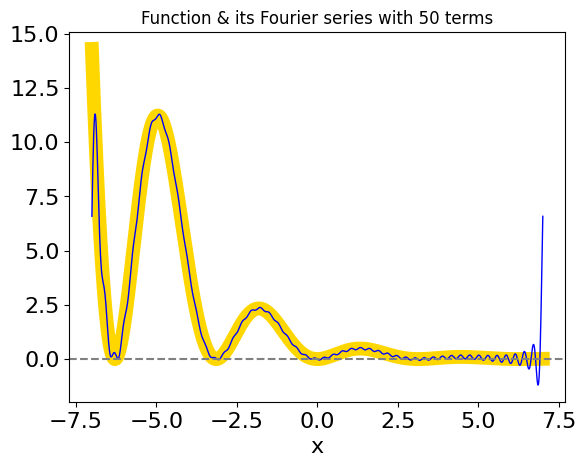
Fig 7. The original function (thick golden line) and its Fourier series (blue). As can be seen the fit is not tremendously good although the series does follow the general shape of the function except at the end points \(\pm 7\). Adding more terms in the series improves the fit, although numerical problems will arise if this is made too large.
4 Generalized Fourier series with orthogonal polynomials#
The Fourier series expands a function in sine and cosines. In the language of vectors and matrices, the sine and cosines form a basis set in which the function f is expanded. The essential property that any basis set of functions must have is orthogonality. If \(\varphi\) is such a function, then the basis set is the functions \(\varphi_1, \varphi_2, \cdots\) and the condition for orthogonality is
where \(c\) is a constant and \(\delta\) is the delta function and is zero if \(n \ne m\) otherwise it is unity. The asterisk indicates the complex conjugate if the function \(\varphi\) is complex. If the functions are normalized as well as being orthogonal, then \(c_m = 1\). The range of the integral, \(a\) to \(b\), depends on the type of function which might be \(\pm 1\) or \(\pm \infty\). Some orthogonal polynomials, such as the Hermite polynomials, are so defined that a weighting function \(w\), is needed to make them orthogonal. In this case, equation (17) is redefined as
Suppose \(f(x)\) is the function we want to expand as a series in the \(\varphi\)’s. The generalized Fourier series is defined in a simpler way than the normal sine/cosine series, because only one function is involved; hence
The next task is to find the coefficients \(a_n\), and this is done by multiplying both sides of (19) by \(\varphi\) and any weighting \(w\), and integrating;
The summation is taken outside the integral in the second step, because it depends on \(n\) not \(x\), and the orthogonality (18) is used to solve the integral. The summation disappears in the last step because of the property of the \(\delta\) function. The coefficients \(a_n\) are therefore,
and this equation and (19) form the equations for the generalized Fourier transform. The only way that information about the function \(f(x)\) enters the calculation, is via the coefficients \(a_n\).
The similarity of (19) to the expansion of a vector in its basis set is clear. In a vector equation in three dimensions, we might write
where \(\boldsymbol i\) is the unit vector along the \(x\)-axis, and then the \(v_m\) are the projections of the vector \(V\) onto this axis. If there were \(n\) dimensions, which clearly cannot be pictured graphically if \(n \gt\) 3, then the \(v_m\) would be projections of \(V\) onto the \(m^{th}\) axis. Similarly, in (19) the \(a_n\) coefficients are the projections of the function \(f(x)\) onto the \(\varphi\), but in this case there are more than three ‘axes’.
The Legendre polynomial \(P_n(x)\) is used as an example of a basis set function with which to calculate the generalized Fourier series of \(\displaystyle e^{-x}\cos^3(x)\) over the range \(\pm \)1. These polynomials appear in problems when an electric charge, perhaps on an ion, is close to other charges, such as from a dipole, or when an electron feels the effect of other electrons and nuclei. All the orthogonal polynomials have several different recursion formulae, and one of the most useful for the Legendre is
for \(n = 2, 3, 4, \cdots\) with \(P_0(x) = 1\) and \(P_1(x) = x\), and the polynomials are defined only over the range \(x = \pm \)1. The weighting function is 1, and their normalization constant \(c_n = 2/(2n + 1)\). Although it is not apparent from the formulae, these polynomials are oscillating functions with an increasing number of nodes as \(n\) increases. The Fourier series using Legendre polynomials instead of sine/cosine is sometimes called the Fourier -Legendre series.
The Chebychev polynomials over the range \(\pm\)1 can be calculated directly as
Some Legendre and Chebychev polynomials are shown in the next figure.
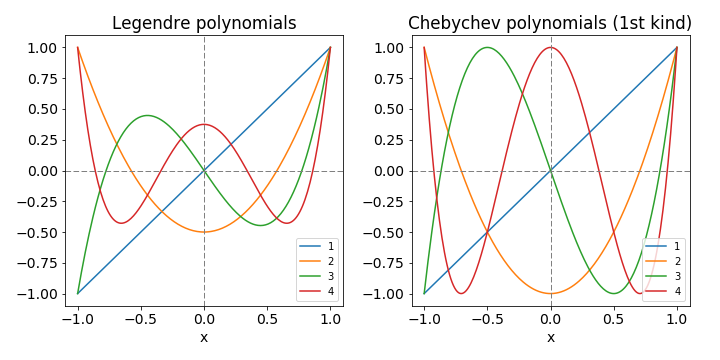
Figures 8 Left: Legendre polynomials. Figure 9 Right: Chebychev polynomials. The numbers indicate the order, \(n\), of the polynomial, \(L(n, x)\) or \(T(n, x)\). The even numbered ones are drawn with a solid line the odd, dashed. Notice the odd - even nature of the functions corresponds to the index number. Both polynomials are limited to the range \(-1 \le x \le 1\).
An example of using Legendre polynomials is shown for the function \(\cos^2(3x)e^{-x}\) in the next calculation. Equations 19 and 20 are used. The fit to he function is good with only 15 terms in the series. For an extended range then the equations need to be put into reduced units to make the range \(\pm 1\).
# using legendre polynomials to form a fourier series.
def P(x,n): # recursion formula
if n == 0 :
return 1
if n == 1:
return x
else:
return ((2*n-1)*x*P(x,n-1)-(n-1)*P(x,n-2))/n # P(n,x)
f = lambda x: np.cos(3*x)**2*np.exp(-x) # target function
w = lambda x: 1.0 # weighting
c = lambda n: 2.0/(2.0*n+1.0) # normalisation
m = 10 # number of terms in series to sum, wiil be v. slow if this is large
numx = 200
x = np.linspace(-1,1,numx)
func = lambda x,n: f(x)*P(x,n)*w(x)
LegFS = lambda x,m: sum( quad(func,-1,1,args=(n))[0]*P(x,n)/c(n) for n in range(0,m))
# Legendre Fourier, quad(...)[0] returns just integral
plt.axhline(0,linestyle='dashed',color='grey',linewidth=1)
plt.axvline(0,linestyle='dashed',color='grey',linewidth=1)
plt.plot(x,f(x),color='gray',linewidth=8,label='function') # original function
plt.plot(x,LegFS(x,m),color='cyan',label='series')
plt.title('Legendre Fourier series and function')
plt.legend()
plt.show()

Figure 9. Legendre series and its fit to the function \(\cos^2(3x)e^{-x}\).
Table: The range of some functions, orthogonal polynomials and weighting factors.#
\(^1\) If the variable \(x\) is actually an angle \(\theta\) then the volume element for the integration has to be changed from \(dx\) to \(\sin(\theta)d\theta\) and in these cases \(\sin(\theta)\) must multiply the weighting function.
4.1 Generating Functions for orthogonal polynomials#
The named orthogonal polynomials are the solutions of specific differential equations. They occur widely in Physics and Chemistry; the Hermite polynomials describe the harmonic oscillator wavefunctions; the Legendre electric charge distributions; and the associated Laguerre the electron distribution in the H atom. The spherical harmonic polynomials are based on the Legendre polynomials, with \(x = \cos(\theta)\), and are used to describe the angular momentum in atoms and molecules; they define the shapes of atomic orbitals, the rotational motion of molecules, and the heat flow around spheres.
The orthogonal polynomials, such as the Legendre polynomial used in the previous section, can be produced from a series expansion of a generating function. These functions have two variables \(x\) and \(u\); expansion is made in the powers of \(u\) and the polynomials are the factors belonging to the terms in \(u^n\) or \(u^n/n!\). A typical series expansion producing polynomial \(p_n(x)\) is
This definition has to be checked, however, as some polynomials do not require \(u^n\) to be divided by \(1/n!\). As an example, the Hermite polynomials can be calculated as the coefficients of \(u^n/n!\) in the expansion of \(\displaystyle f(x, u)=\exp(-u^2+ 2xu)\), thus the Hermites found from the expansion \(\displaystyle \exp(-u^2+2xu) = \sum\limits_{n=0} H_n(x)u^n/n!\). The expansion is
Using SymPy to do this is simpler, the coefficients in \(x\) of \(u^n/n!\) are the Hermite polynomials
x, u = symbols('x, u')
f01 = exp(-u**2 + 2*x*u) # expand terms to get series to u^10
s = series(f01,u,n = 10)
print('Hermite Polynomials H(n,x) from n =1 to 9')
for n in range(1,10):
print('H(',n,',x) ', s.coeff(u**n)*factorial(n)) # extract coefficients. factorial is inbuilt in SymPy
# now plot data
xx = np.linspace(-2,2,100)
cols=['red','blue','green']
for i,k in enumerate( [5,6,7] ):
f01 = lambdify(x, s.coeff(u**k)*factorial(k) ) # make algeraic answer into function
plt.plot(xx, f01(xx),color=cols[i],label='H('+str(k)+',x)')
plt.axhline(0,color='grey', linewidth=1)
plt.ylim([-1.1e3,1.1e3])
plt.legend(fontsize=10)
plt.show()
Hermite Polynomials H(n,x) from n =1 to 9
H( 1 ,x) 2*x
H( 2 ,x) 4*x**2 - 2
H( 3 ,x) 8*x**3 - 12*x
H( 4 ,x) 16*x**4 - 48*x**2 + 12
H( 5 ,x) 32*x**5 - 160*x**3 + 120*x
H( 6 ,x) 64*x**6 - 480*x**4 + 720*x**2 - 120
H( 7 ,x) 128*x**7 - 1344*x**5 + 3360*x**3 - 1680*x
H( 8 ,x) 256*x**8 - 3584*x**6 + 13440*x**4 - 13440*x**2 + 1680
H( 9 ,x) 512*x**9 - 9216*x**7 + 48384*x**5 - 80640*x**3 + 30240*x
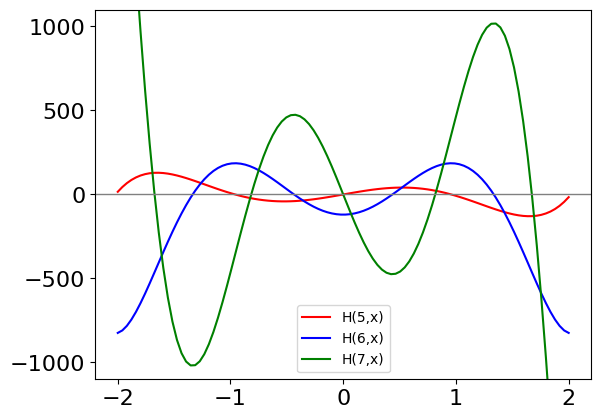
Figure 10. Some of the Hermite polynomials calculated using a generating function. The series produced is exact.
Other polynomials that are frequently met are the Legendre, associated Legendre, Laguerre, associated Laguerre, and Chebychev. The associated Legendre and associated Laguerre polynomials are obtained by differentiating their respective polynomials by \(x\), \(n\) times, but in these cases, and perhaps in others also, it is easier to use Rodrigues’s derivative formula or one of the recursion equations to generate the polynomials. See Margenau & Murphy (1943) and Arkfen (1970) for a full discussion of these polynomials and generating functions.
The generating function definitions, and a derivative formula for integral \(n\) and \(k\), are shown in the next table. The associated Legendre generating function is omitted because of its complexity.
It is worth noting in passing that generating functions play a more general role in mathematics than is described here and are used to form various distribution functions and series of numbers. The generating function \(1/(1 - x)\) produces a square wave or \(-1, +1\) repeating sequence; the function \(1/(1 - ax)\) produces the sequence of increasing integer powers of \(a\); and \(x/(1 - x - x^2)\) generates the Fibonacci sequence. For example,
x = symbols('x')
f01 = x/(1 - x - x**2) # expand terms to get series to u^10
s = series(f01,x,n = 30)
print('Fibonacci from n = 1 to 20')
for n in range(1,21):
print(' ', s.coeff(x**n),end='') # extract coefficients.
Fibonacci from n = 1 to 20
1 1 2 3 5 8 13 21 34 55 89 144 233 377 610 987 1597 2584 4181 6765
Other generating functions can, for example, be used to work out the number of ways of selecting several items from a list, where the same item can be picked many times.


